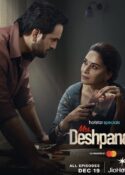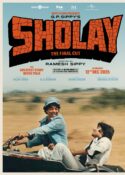 Amit Rai is making his debut as director in the film Road To Sangam. A small article in a leading newspaper had caught his attention. Later he developed the same into a full feature film, approached his name sake Amit Chheda, and had his first film on floors with the ensemble of best of the performers in it. Road to Sangam, a film inspired from Gandhiji and his principles, has already managed to get three awards in three different international film festivals, including Viewer’s Choice Award at MAMI. Latest in the Awards galore are three awards at Los Angles Reel Film Festival, and the categories were Best Foreign Film, Best Foreign Film Original Score and Best Foreign Film production Design. The film also received thunderous applause at CANNES.
Amit Rai is making his debut as director in the film Road To Sangam. A small article in a leading newspaper had caught his attention. Later he developed the same into a full feature film, approached his name sake Amit Chheda, and had his first film on floors with the ensemble of best of the performers in it. Road to Sangam, a film inspired from Gandhiji and his principles, has already managed to get three awards in three different international film festivals, including Viewer’s Choice Award at MAMI. Latest in the Awards galore are three awards at Los Angles Reel Film Festival, and the categories were Best Foreign Film, Best Foreign Film Original Score and Best Foreign Film production Design. The film also received thunderous applause at CANNES.
Here’s what director Amit Rai had to say:
From where did you get the idea to make a movie involving Gandhiji and Gnadhigiri?
The story idea came from a television report where it was mentioned that the Allahbad museum is going to restore an old vehicle by repairing it. This was the same vehicle in which Mahatma Gandhi’s ashes were carried to Sangam. I found the thought very symbolic with our country where people of different religions are staying together. Like the engine of any vehicle where different nuts and bolts have to work in tandem to make it work, likewise in a nation like ours, all have to work together to take the country ahead. If any parts (religion) is not working properly, it can damage whole system. We used clippings of Gandhiji’s procession of his last journey.
 How did you manage to recreate a replica of the original vehicle or did you manage to get the same one from the museum?
How did you manage to recreate a replica of the original vehicle or did you manage to get the same one from the museum?
No we do not have the original vehicle, it is national heritage. We made a replica of the original vehicle which is there in the museum. We took help from the same person who has repaired the original engine. He helped our art director. We struggled lot for the same ’48 Ford V8 engine also which we found finally in Lucknow. This all took around 1 and half year. Because of such a perfect replica of the vehicle, people of Allahabad tried to stop the shooting; they thought the filmmaker took the historical car for the shoot and thought that museum people were so irresponsible that they have given it also.
Is this movie based on Mahatma Gandhi or Gandhigiri?
We have Gandhiji in story but it’s not a story about Gandhigiri or Gandhiwad. It’s a story of any normal person and how he can simply apply his [Ghadni’s] ideology in real life even today and how it effects society and the people around. It’s not a story against any particular community, but it’s their point of view to see the situation and how they react to it.
 While doing research for the film, what have you learned about Gandhi?
While doing research for the film, what have you learned about Gandhi?
Gandhiji was so religious in his own personal life but he always put nationalism above religion. After the death of Gandhiji, no one from that particular community (of Muslims) talked about it. In the film Road to Sangam, we have tried to portray their point of view in all honesty. In fact, we have dialogues in which a Muslim community leader acknowledges that Gandhiji had died for us.
What role is Paresh playing and how did you convince him to do the film?
Pareshji is playing the character of Hashmat Ullah Khan, the person who was responsible for repairing the original engine. I had thought of only three people for this role but once we narrated the script to Pareshji, he immediately agreed. In fact, so impressed was he with the character that he did his own research for it. He met the real Hashmat Ullah and then went in for his own look.
Would you call it a hard hitting film?
No, the film is not hard hitting, it’s a feature film but it will definitely leave everybody thinking. In fact, who ever has seen the film at various festivals, have all praised it. Even the younger generation has been very, very positive about this film. Since the film is a mix of real incidents and fiction, we have characters that are actually there. We have shot the film in Allahabad, at actual locations. We do have some hard hitting dialogues but the entire community supported us during the making because there is nothing malicious or wrong.
 What was going on in your mind while writing the script?
What was going on in your mind while writing the script?
I always used to think about family’s property dispute, disputes in religion, state, country. That is what I have tried to put in the mind of my protagonist. He feels strongly about his community but he does not separate it from the country. His belief is to come together to make it into a stronger country and in the end, strength for all its people.
I also specially feel people who stayed here during the time of Partition are not just a vote bank. They are the citizens of the country and hence its strength. They should not allow anybody to use them as one and instead become part of the mainstream growth and ignore minor irritants. Before making the film I had studied all the documents of Muslim communities from the time of Partition and then have tried my best to do justice to their psyche. While reading all those documents, I also got to know that Mahamad Ali Zina was always more interested in Waziristan more than Pakistan.
What brought you to films?
I have done my best plays in Marathi though I am a non Maharashtrian. But to do my first love theatre, I had to learn the language and thoroughly enjoyed the process. One of my award winning plays are Hai Wadan with Girish Karnad, Aashad Koirin, Mahabhooj, Chokat Vihiri, Dagad Aot. I have also assisted Anurag Basu for his movie Tum Mile to get technical knowledge.









